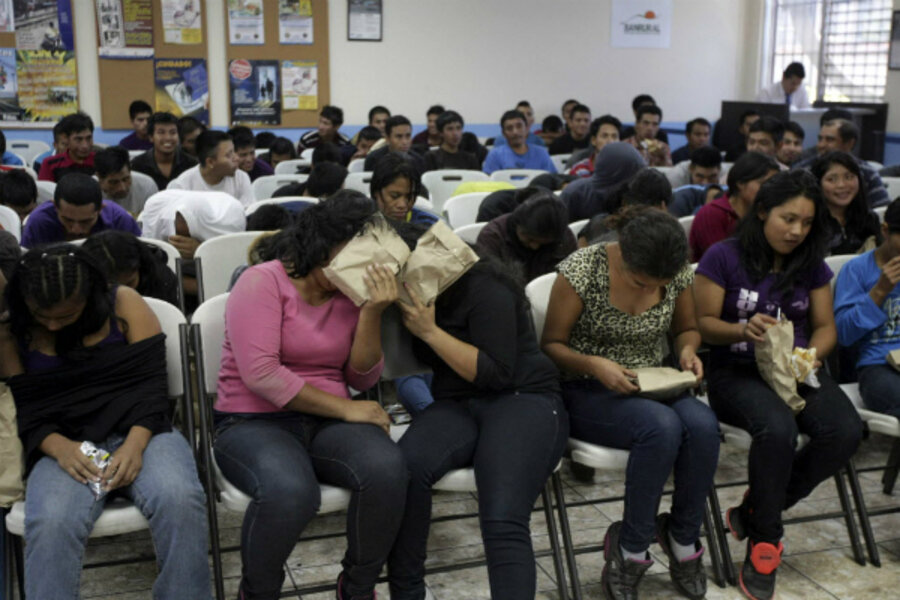Border crisis: Should Obama send in the National Guard?
Loading...
| WASHINGTON
Lawmakers in Texas, including Gov. Rick Perry (R), as well as Republicans in Congress are urging President Obama to send America’s prime military reserve to the southern border to help handle the child-migrant surge. The president has been resisting, but this week, he opened the door – a crack.
No action from the commander in chief yet, but Mr. Obama did tell Governor Perry during his recent visit to Texas that he would “be happy to consider” deploying the guard, if that’s what it takes to get the Texas delegation in Congress to sign off on his $3.7 billion request in emergency spending on the border crisis. On Friday, House Appropriations Committee Chairman Hal Rogers (R) – not a Texan but a powerful Kentuckian when it comes to spending – said the president's plan is too big and the House won't approve it. He did say, however, that his committee is now considering pieces of it.
So, would it be a good idea to send the guard? D.C. Decoder looks at this question in a Q&A:
What’s the (mostly) Republican argument for tapping the National Guard?
House Speaker John Boehner (R) of Ohio mentioned the guard idea in a June 20 letter he sent to Obama about the border crisis. First, he said, the National Guard is “uniquely qualified” to respond to humanitarian crises and can help deal with the needs of the migrant children and their families. Second, the guard can help relieve the border patrol along the Rio Grande River section of the US southern border so its agents can “focus on their primary duty of securing our border.”
In an election year, it also makes good politics. Securing the border is a key GOP demand on the immigration issue generally. The first reaction from the speaker’s office to the White House request for emergency funding on Tuesday was to note that it did not include the National Guard.
Why is the administration reluctant?
The main reason is that enforcement is not the issue, according to the Obama administration. These unaccompanied child migrants – with as many as 90,000 expected to be apprehended by the time this fiscal year finishes at the end of September – are not trying to evade border patrol agents. They are looking for them, hoping that the patrol will pass them through a clogged-up processing system that allows them to stay in the United States.
Building up the power to apprehend won’t stem the tide, said Homeland Security Secretary Jeh Johnson at a hearing on Capitol Hill Thursday. And because the crossings are occurring mostly in one zone, the Texas Rio Grande Valley, there’s no need for wider border enforcement, as in years past. Moreover, he said, sending the National Guard is “hugely expensive.”
The political consideration is that more guard troops on the border might anger the president’s Democratic base and bolster GOP claims that the surge of immigrants is a national security crisis.
Has the National Guard been sent to the border before?
Yes. In 2006, President George W. Bush sent 6,000 guard forces to the border to help turn back the tide of illegal immigration. It was a controversial move at the time, as critics warned of a militarized border. Also, the guard did not have the authority to apprehend migrants on US soil. Instead, they acted as lookouts and built roads and fencing. The National Guard assisted in 186,814 apprehensions during the 2006-08 program, according to a Government Accountability Office Report.
Border governors deemed the program a success, and in 2010 Obama ordered 1,200 guard troops to the border. In Texas, the troops helped catch about 4,000 illegal immigrants in more than 18 months, according to a June report in the Austin American Statesman newspaper. Critics saw Obama’s move as largely political, to show that he could be tough on illegal immigration long enough to muster support for comprehensive immigration reform, so that he could later ease up.
What’s the state of play now?
The guard force at the border has been scaled back considerably to 300 soldiers. Its mission has changed from one on the ground to one in the sky. The guardsmen mainly do night flying in helicopters above the Texas border with Mexico. The Austin American Statesman finds that this smaller force and airborne mission are more effective than the 2010 deployment of ground forces, resulting in 10 times the apprehensions a similar period. But the mission is in danger due to possible Pentagon budget cuts.
Meanwhile, a private militia group has set up a command center south of San Antonio to protect the US from illegal immigration, according to media reports. It’s operating through the website PatriotsInformationHotline.com and plans to deploy militia forces along the border within a few weeks.
Customs and Border Protection said in a statement that “it does not endorse or support” any private group or organization taking matters into its own hands. “CPB appreciates the efforts of concerned citizens as they act as our eyes and ears,” the statement said. “Securing our nation’s borders can be dangerous. Interdicting narcotics and deterring and apprehending individuals illegally entering the US requires highly trained law enforcement personnel.”






